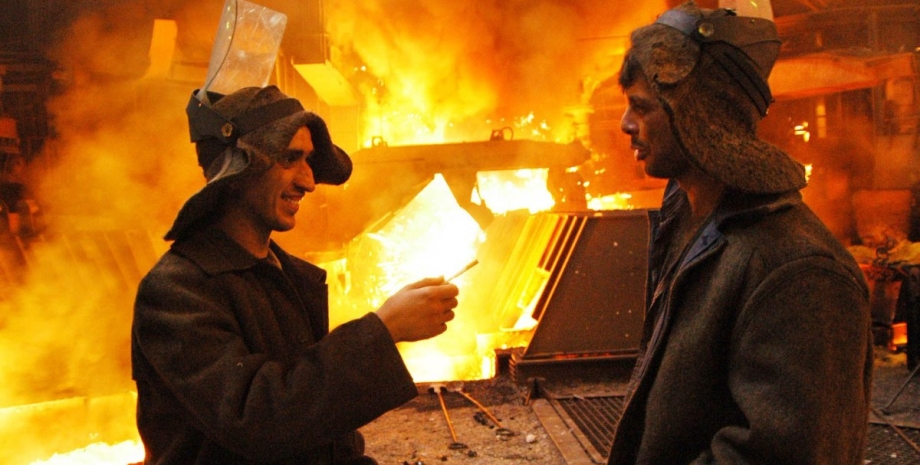
 By Victor Duda
By Victor Duda
However, it is a sand compared to the multibillion -dollar losses of the industry and the economy as a whole. Ukrainian metallurgy has been suffering from Russian occupation for the first time. Dmitry Churin, Director of the Analytical Department of the Eavex Capital Investment Company, reminds that Russia's aggression in 2014-2015 led to the loss of metallurgical enterprises in the occupied territories of Donetsk and Luhansk regions.
It is about the following capacities: "In 2022, the destruction of" Azovstal "and" Mariupol Metallurgical Plant "led to a painful blow throughout the Ukrainian industry, since the metallurgical industry is associated with a fairly long chain ", - continues Dmitry Churin. Two Mariupol enterprises of Metinvest Group Rinat Akhmetov accounted for about 40% of Ukrainian steel production.
And since the metallurgical sector has historically made a significant contribution to Ukrainian GDP, the losses of metallurgy were painful in the economy, which in 2022 was sought by more than 30%. "Since March last year, the enterprises of the Mining and Metallurgical Complex (GMK) in the territory controlled by Ukraine continue to work for a loss," says Alexander Kalenkov, President of the Association 85%, mining enterprises-by 75-80%.
" The focus interlocutor explains this by the fact that in the first days after a full -scale invasion of the Russian army, these enterprises have significantly reduced employees or even completely stopped production. The next blow on the surviving capacity was caused by Russian energy terrorism. "Metallurgy is one of the largest consumers of electricity.
Therefore, during the full blackouts of the enterprise, the industry stops, and some are completely stopped for the entire winter because of restrictions on electricity supply," - said Dmitry Gorununov. According to Oleksandr Kalenkov, some enterprises in such circumstances are forced to reduce production and invest in industrial electrical generators, which also affected the increase in the cost of production and, as a consequence, a decrease in its competitiveness in the world markets.
"Large enterprises of Dnipropetrovsk and Zaporizhzhya regions have not completely stopped production, although they significantly reduced volumes," said Viktor Shulik, Director of the Department of Management of Ra RA "II-Rating. " . Some of them tried to move production, for example, to Khmelnitsky, but technologically it was very difficult to do it.
Therefore, metallurgical enterprises near the demarcation line stop activity, and in relatively safe regions try to adjust to the schedules of power outage. " Shulik adds that metallurgy is, first of all, color, has a significant dependence on the stability of electricity supply, so most enterprises of the industry do not provide the possibility of compliance with the cycle.
Moreover, businesses in the relatively safe regions, according to the interlocutor of the focus, are also felt by personnel hunger. In the current situation, the shrinkage of metallurgical production looks like a natural scenario. "After the war, production fell almost immediately by more than 80%," reports Focus Konstantin Fastovets, the head of the Analyt Capital analytics department.
However, problems with logistics, demand and shutdown of power supply have already led to the fact that, for example, Metinvest also reduced the production of ore by 90%in the third quarter. " The Eavex Capital investment company evaluates the fall in steel production in Ukraine almost four times in 2022 compared to 2021. According to the OP "Ukrmetalurgprom" for 2022, 6. 3 million tons of steel were produced at Ukrainian enterprises - only 30% of the 2021 indicator.
In particular, Metinvest Group reports that Ukrainian companies of the groups, except those located in Mariupol and Avdiivka (MK Azovstal, MMK named after Illich and Avdiivsky KHZ), continue to work with different levels of loading, taking into account safety, logistical and logistical Economic factors. As a result, for 9 months of 2022, the production of cast iron and steel group "Metinvest" compared to the same period last year decreased by 65% and 62%.
At the same time, the production volumes of the Kametstal enterprise (Dnipropetrovsk region) partially compensated for the stop of Mariupol capacities. The level of production is significantly asked at other large enterprises of Ukraine. Recently, ArcelorMitthal Kryvyi Rih reported on production results for 2022. "Last year, the Ukrainian Mining and Metallurgical Industry met with the most severe challenges in the history of independent Ukraine.
The volume of production of steel industry in the country has decreased by 70%in the country. Due to a full-scale war in Ukraine, reducing export capacity and restriction in energy supply, production capacity" "During 2022, no more than 20-25%was loaded," the company's press service said. It stated that only in 2022 the level of production of enterprises of the company fell five times. For example, ore production amounted to 11. 6 million tonnes instead of planned 26.
4 million tons, and cast iron production - 1. 6 million tonnes instead of a plan of 5. 6 million tons, steel - 1. 2 million tons instead of a plan of 5. 1 million tons. Source: ArcelorMittal Kryvyi Rih press service, taking into account the fall in production level and metallurgical export, the situation is disappointing. In 2021, ferrous metals were the most powerful article in the structure of Ukrainian foreign trade - $ 13. 95 billion (+81. 4% compared to 2020). At that time, ferrous metals were 20.
5% of the total export revenue. In 2022, ferrous metals exports decreased to $ 4,533 billion (-67. 5% compared to 2021), and the share in export structure decreased to 10. 26%. Source: OP "Ukrmetalurgprom" at OP "Ukrmetalurgprom" add that since the war, the geography of exports has changed markedly due to the blocking of seaports - if earlier to EU countries Ukraine supplied about a third of the production of GMC, then in 2022 - more than 60%.
"Economic factors have affected," explains the reasons for the fall of exports Alexander Kalenkov. "On the one hand, because of the aggression of the Russian Federation, prices and demand in the world markets have fallen, because, in particular, they temporarily stopped the production of dozens of plants in EU countries - the only available market for us.
On the other hand, the cost of our products has increased, in particular because the logistics load in the conditions of port blocking increased 4-5 times. " According to Dmitry Churin, the exports of semi -finished products made of steel and hot rolled rolled show the drama of the loss of Mariupol metallurgical plants.
The focus interlocutor adds that a significant fall in export revenues has not only a reflection of wartime problems, but also showed the overall vulnerability of Ukraine's economy to lose the ability to supply goods through seaports. From August 1, the so -called grain corridor began to operate within the framework of international agreements, allowing the harvest from Odesa, Chernomorsk and Southern. Since then, Ukraine has exported 18. 4 million tons of grain.
Meanwhile, metallurgical maritime exports remain on the pause from the beginning of the Russian invasion. According to Oleksandr Kalenkov, the GMC is most other sectors of the Ukrainian economy depends on export capabilities - in foreign markets Ukraine sold about 60% of mining and 80% of metal. About 70% of metallurgy products were sent abroad through seaports.
"Under the current price conditions in the world markets, Ukraine does not receive more than $ 630 million foreign exchange earnings on a monthly basis due to the inability to export GMK products through ports. Prices," Alexander Kalenkov notes. The expert adds that the opening of ports for Ukrainian metal will restore the loading of both metallurgical enterprises and related industries, which will significantly increase taxes in the budget.
Representatives of the Ukrainian authorities declare the desire to open a sea corridor for metallurgical exports. In particular, the first Viceremier-Minister-Minister of Economy of Ukraine Yulia Sviridenko declared at the World Economic Forum in Davos (Switzerland) that Ukraine wants to expand the export of steel in addition to an important grain export agreement.
Konstantin Fastovets notes that the grain managed to agree with Russia through the mediation of the UN and Turkey as a socially important product for the whole world. In this context, the focus interlocutor suggests that the seaports for metallurgy will most likely remain closed until the end of the war.
"Ukraine has repeatedly emphasized the need to expand the corridor to other ports - in particular, to Nikolaev and other goods - metallurgical products and ore," continues Dmitry Gorununov, the senior economist of the Center for Economic Strategy. The continuation of the [action of the corridor] was possible only in the old format with the same list of ports and for the same four months, the chances of including other goods are small.
" The war and energy crisis in Ukraine continue, which means that the metallurgical industry of Ukraine has another difficult year. "So far, 2023 will remain crisis for the metallurgical industry of Ukraine," Dmitry Churin thinks. "The situation will change for the better as soon as military risks will begin to decline and, finally, the opportunity to export Ukrainian steel through domestic seaports.
" According to Dmitry Goryunov, the current low level of capacity loading will remain in victory or at least until the opening of portal ports for metallurgy or diplomatic. Oleksandr Kalenkov notes that after the victory over the aggressor on Ukraine is waiting for post -war recovery, and therefore significant investments in the restoration of infrastructure, mechanical engineering, housing construction, which provides for an increase in domestic demand for metal.
This will allow the industry to recover at a rapid pace. According to Ukrmetalurgprom OP, in the peaceful and relatively peace years, the capacity of the domestic metal market in Ukraine was an average of about 5 million tons per year. In 2022, this figure dropped up to 2 million tons. But if after the victory of metal consumption per capita in Ukraine will increase to the level of Eastern Europe, the domestic market capacity will increase to 15-20 million tons per year.
It is important that this demand satisfies Ukrainian metal. Since, according to Oleksandr Kalenkov, it will allow to download the restored capacity of the domestic GMC and will have a multiplicative effect on the whole economy, because many other industries depends on the work of the MMC - chemical, energy, machine -building, transport and others. "Metallurgists talk about the possibility of restoring production [at the surviving capacity] for six months-year.










All rights reserved IN-Ukraine.info - 2022